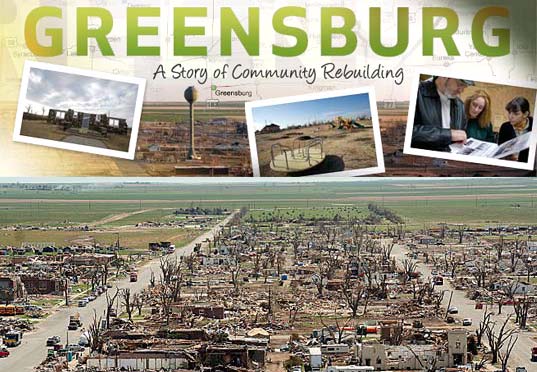
Πώς ένας ανεμοστρόβιλος έπεισε την τοπική κοινωνία να ξαναχτίσει την πόλη ως πράσινη
Στις 4 Μαΐου 2007, ένας τεράστιος ανεμοστρόβιλος κατέστρεψε ή προκάλεσε σοβαρές ζημιές στο 95% της κωμόπολης Greensburg, Kansas στις ΗΠΑ. Οι πρώτες αναφορές για τον ανεμοστρόβιλο υπολόγισαν ότι το 75-90% των κτιρίων υπέστησαν ζημιές ή καταστράφηκαν. Μεγάλο μέρος αυτής της ζημιάς αφορούσε το κέντρο της πόλης. Μικρές περιοχές έξω από την πόλη δεν υπέστησαν σοβαρές ζημιές, όπως άλλες περιοχές. Οι εκτιμήσεις για τη ζημιά στην πόλη ανέβασαν το συνολικό κόστος σε πάνω από 9 εκατομμύρια δολάρια. Το μεγαλύτερο ποσοστό της πόλης χρειαζόταν πλήρη ανοικοδόμηση.

Going Green: Ο ανεμοστρόβιλος λειτούργησε ως σημείο καμπής για την πόλη. Άλλαξε τον τρόπο σκέψης και τη στάση των ανθρώπων εκεί, σε σχέση με το πώς πρέπει να ξαναχτιστεί η πόλη. Από την στιγμή εκείνη οι ηγεσίες της πόλης και της κοινότητας δεσμεύτηκαν να ανοικοδομήσουν την πόλη ως ένα πρότυπο βιώσιμης αγροτικής κοινότητας. Οι στάσεις και οι απόψεις σχετικά με τη διαδικασία ανοικοδόμησης διαμόρφωσαν ξεκάθαρα την κατεύθυνση που πήρε η μικρή αυτή πόλη στην επιλογή της να γίνει πράσινη, και τις λύσεις που προωθήθηκαν. Η πόλη έθεσε ως στόχο να είναι αυτάρκης και να χρησιμοποιήσει τις νεότερες και καλύτερες τεχνολογίες στην ανοικοδόμηση. Ένας από τους στόχους του πράσινου σχεδίου ήταν επίσης να φέρει περισσότερους ανθρώπους στην πόλη. Οι ελπίδες της πράσινης πόλης να φέρει νέους ανθρώπους ήταν παρούσες ακόμη και στα στάδια προγραμματισμού.
Η ιδέα μιας μικρής πόλης να εφαρμόσει τα νεότερα σχέδια για την (ανα)κατασκευή των κτιρίων και να πετύχει όσον το δυνατόν λιγότερα απόβλητα ακόμα και σε σχέση με τα υλικά από τα γκρεμισμένα κτίρια είναι ένας φιλόδοξος στόχος για κάθε κοινότητα. Το Greensburg είχε ένα πλεονέκτημα, ήταν σε θέση να ανοικοδομήσει σχεδόν κάθε κτίριο στην πόλη από τα ερείπια.
Στον αρχικό προγραμματισμό καθορίστηκε ότι η πηγή ενέργειας της πόλης θα ήταν ίδια με αυτή του ανεμοστρόβιλου, δηλαδή ο άνεμος. Θα έπρεπε η αιολική ενέργεια να καλύπτει τις ανάγκες της και κάτι περισσότερο καθώς η πόλη μεγάλωνε. Η χρήση της αιολικής ενέργειας ήταν κεντρική στη διαδικασία ανοικοδόμησης, χωρίς να χάσει τον συμβολισμό της, δηλαδή ο αέρας που κατέστρεψε την πόλη, θα τροφοδοτούσε την αναγέννηση της πόλης. Πολλές περιοχές στο Δυτικό Κάνσας έχουν στραφεί στην αιολική ενέργεια για να συμπληρώσουν την οικονομία της περιοχής και να καλύψουν τις ανάγκες τους σε ηλεκτρική ενέργεια. Τα αιολικά πάρκα στο Κάνσας παρέχουν μια αξιόπιστη πηγή ενέργειας, αλλά υπάρχουν λίγες βιομηχανίες στο αγροτικό Κάνσας που σχετίζονται με τα αιολικά πάρκα. Η πόλη στόχευσε να εξασφαλίσει για τις ανάγκες της 100% ανανεώσιμες πηγές ενέργειας, στο 100% του έτους. Το αιολικό πάρκο ολοκληρώθηκε την άνοιξη του 2010, μέσα σε 2 χρόνια δηλαδή, κι αποτελείται από 10 ανεμογεννήτριες 1,25 megawatt (MW) που παρέχουν 12,5 MW ανανεώσιμης ενέργειας στην πόλη. Αυτή είναι ενέργεια που επαρκεί για να τροφοδοτείται κάθε σπίτι, επιχείρηση και δημοτικό κτίριο στο Greensburg. Η πόλη αξιοποιεί περίπου το 1/4 έως το 1/3 της ισχύος που παράγεται επιτυγχάνοντας τον στόχο του «100% ανανεώσιμες πηγές ενέργειας, 100% του έτους». Η ενέργεια που περισσεύει διοχετεύεται ξανά στο δίκτυο και προσφέρεται ως “πιστώσεις ανανεώσιμης ενέργειας” για άλλους πελάτες του Kansas Power Pool και της NativeEnergy.
Το Δημαρχείο που καταστράφηκε από τον ανεμοστρόβιλο ξαναχτίστηκε με πράσινη οπτική. Ενσωματώθηκαν ηλιακά πάνελ, αντλίες θερμότητας εδάφους, υλικά από ανάκτηση και μια φυτεμένη στέγη (πράσινη στέγη). Το κτίριο χρησιμεύει πλέον ως σύμβολο της ζωτικότητας και της ηγεσίας της πόλης στην προσπάθεια να γίνει μια βιώσιμη κοινότητα όπου οι κοινωνικές, περιβαλλοντικές και οικονομικές ανησυχίες βρίσκονται σε ισορροπία. Το Δημαρχείο είναι ενεργειακά αποδοτικό και επιτυγχάνει μείωση κατά 38% σε σύγκριση με ένα αντίστοιχο κτίριο που ακολουθεί τις τυπικές προδιαγραφές. Με την εγκατάσταση και ενός φωτοβολταϊκού συστήματος 4,8 kW, το Δημαρχείο επιτυγχάνει επιπλέον 8% ετήσια εξοικονόμηση ηλεκτρικής ενέργειας, με την συνολική εξοικονόμηση ενέργειας να φτάνει περίπου το 46%.
Όλες οι πτυχές της κοινότητας θα ακολουθούσαν την ιδέα της βιώσιμης διαβίωσης, αναζητώντας και επιτυγχάνοντας πιστοποίηση LEED® Platinum για πολλά από τα κτίρια. Για την επίτευξη αυτού του στόχου, το Greensburg έπρεπε να συνεργαστεί με άλλους. Με τη βοήθεια και την ώθηση της κοινότητας, μεγάλο μέρος της εργασίας για την ανοικοδόμηση της πόλης πραγματοποιήθηκε μέσα σε μόλις δύο χρόνια. Αρκετές εταιρείες δώρισαν χρήματα, νερό, τρόφιμα και άλλες προμήθειες για την ανοικοδόμηση του Greensburg. Η κάλυψη του σχεδίου από τα μέσα ενημέρωσης και οι προσπάθειες πράσινης ανοικοδόμησης της πόλης έπαιξαν σημαντικό ρόλο στη διαμόρφωση θετικής στάσης από τους πολίτες σχετικά με το πράσινο σχέδιο του Greensburg. Τα δημοσιεύματα και τα ντοκιμαντέρ που έχουν δημιουργηθεί για την πόλη δίνουν έμφαση στην πράσινη πτυχή της διαδικασίας ανοικοδόμησης, ενώ μερικά και στην ενεργοποίηση των πολιτών και της πόλης για την ανοικοδόμηση. Η αφήγηση γύρω από μια κοινότητα που κινητοποιείται και ανοικοδομεί την περιοχή της μετά από μια καταστροφή χρωμάτισε πολλές από τις αναφορές στην περιοχή. Η προσοχή των μέσων ενημέρωσης βοήθησε, επίσης, να διαμορφωθεί η ιστορία μιας πόλης που ξαναχτίστηκε πράσινη, και αυτή η δημοσιότητα βοήθησε την πόλη να προσελκύσει χορηγούς για τις ανάγκες ανοικοδόμησης. Αν και μεγάλο μέρος της προσπάθειας ανοικοδόμησης χρηματοδοτήθηκε από εταιρείες, η πόλη παρέμεινε ως επί το πλείστον οικονομικά ανεξάρτητη.
Η ύπαρξη σχεδίου για την ανάπτυξη μιας πράσινης πόλης ήταν κρίσιμη για την ανοικοδόμηση του Greensburg. Η ανάπτυξη του σχεδίου προκάλεσε, όμως, στην αρχή μια κάποια ένταση μεταξύ του δημοτικού συμβουλίου και των κατοίκων της πόλης. Είναι αυτονόητο ότι όταν αντιμετωπίζουν μεγάλα αγχωτικά γεγονότα, οι άνθρωποι δεν πρόκειται πάντα να συμφωνήσουν σχετικά με τον τρόπο με τον οποίο θα προχωρήσουν. Ακόμη και με δυσκολίες, η πόλη μπόρεσε – μετά από διάλογο και με τη συμμετοχή των κατοίκων στις συναντήσεις με τις αρχές και τους ειδικούς – να διαμορφώσει ένα βιώσιμο ολοκληρωμένο σχέδιο που σκιαγράφησε τους τρόπους με τους οποίους το Greensburg θα ήταν μετά την ανοικοδόμηση μια περιοχή που ταιριάζει στο όραμα για ζωή σε μια Πράσινη πόλη. Η διοίκηση της πόλης ένιωσε ότι χρειάζεται ένα σχέδιο και έδωσε την δυνατότητα στους πολίτες να συμμετάσχουν στη λήψη των αποφάσεων για το πώς η πόλη τους θα προχωρούσε.
Ειδικοί από το Υπουργείο Ενέργειας των ΗΠΑ (DOE) και το Εθνικό Εργαστήριο Ανανεώσιμων Πηγών Ενέργειας (NREL) συνεργάστηκαν με τους φορείς της πόλης, ιδιοκτήτες επιχειρήσεων και τους κατοίκους για να εντοπίσουν τρόπους ενσωμάτωσης της ενεργειακής απόδοσης και τεχνολογιών ανανεώσιμης ενέργειας στα νέα κτίρια.
Η πόλη μπορεί πλέον να χρησιμεύσει ως πρότυπο για άλλες πόλεις που πλήττοντα από καταστροφές για το πώς θα μπορούσαν να τις αντιμετωπίσουν μέσα από νέες, σύγχρονες, πράσινες αντιλήψεις. Η τοπική και ομοσπονδιακή βοήθεια για την ανοικοδόμηση της πόλης ήταν μοναδική για την περιοχή και μπορεί να δείξει και σε άλλες πόλεις που αντιμετωπίζουν παρόμοιες φυσικές καταστροφές πώς η σωστή επικοινωνία, η υποστήριξη της κοινότητας και η επικοινωνία του σχεδίου βοήθησαν την πόλη να ξαναχτιστεί γρήγορα και αποτελεσματικά.
Επίσης η πράσινη οπτική διαπερνάει πλέον όλες τις υποδομές και δραστηριότητες της πόλης όσον αφορά το φωτισμό, τη θέρμανση και τον δροσισμό, τα υλικά που χρησιμοποιούνται, την διαχείριση του νερού, τους δημόσιους χώρους αλλά και τα ιδιωτικά κτίρια.
Πράσινο είναι και το κέντρο τεχνών της πόλης 5.4.7 Arts Center.
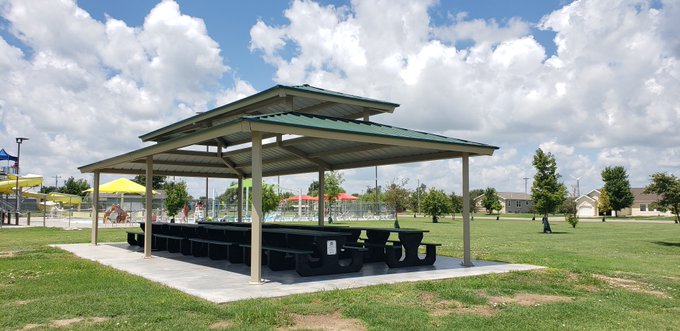
Το Greensburg ξεκίνησε να αποτελεί πρότυπο βιώσιμης, πράσινης κοινότητα αλλά και βιώσιμης ανοικοδόμησης μέσα από ένα πράσινο σχέδιο.
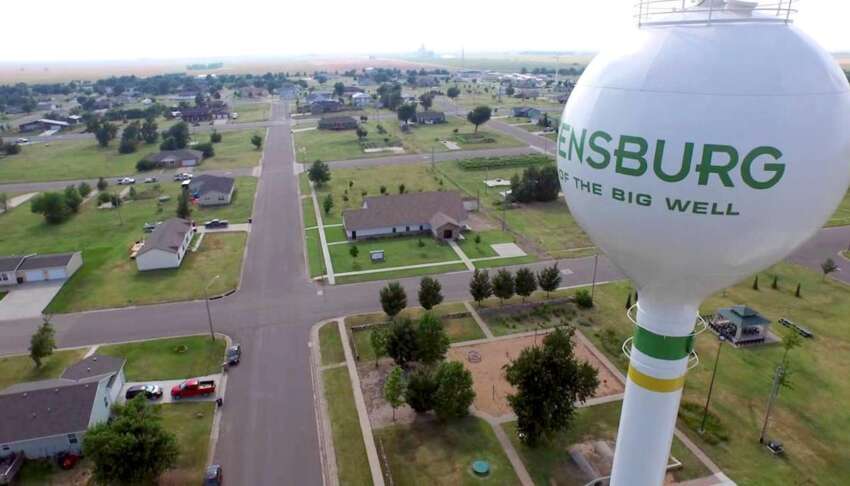
—————————————————————————————————————————————————————————————————————————————————————
How a tornado served as aturning point for a town and changed minds of the people to Go Green
On May 4, 2007, a massive tornado destroyed or severely damaged 95% of Greensburg, Kansas. Early reports on the tornado noted that 75-90 percent of buildings were damaged or destroyed. Much of that damage went through the center of the town. Small areas on the outside of the town were not badly damaged as other areas. Price estimates of the damage to the town put the total cost above 9 million dollars. The personal and city responsibility of rebuilding was catastrophic as most of the town needed complete rebuilding
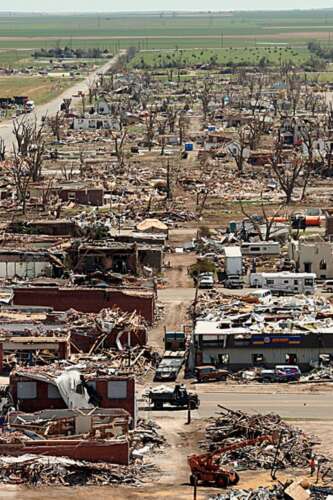
Going Green: The tornado served as a turning point that allowed the town to rebuild. It also changed minds and attitudes of the people there, concerning how the town should rebuild itself. Since then, city and community leaders have been committed to rebuilding the town as a model sustainable rural community. Attitudes and views on the rebuilding process clearly shaped the direction Greensburg went in its choice to go green, and the sacrifices that went along with that choice. The town set a goal to be self-sufficient and to use the newest and best technologies in rebuilding. One of the goals of going green was to bring more people into town. The idea of a small town with the newest building designs and creating less waste is a lofty goal for any community. Greensburg possessed an advantage in being able to rebuild nearly every building in the town. Hopes of the green town bringing in new people was present even in the planning stages. In early planning it was determined that the level of energy use would be at least that of the townpre-tornado, and possibly more as the town grew. The town decided to move toward wind energy, as a natural occurring resource in western Kansas. The use of wind energy was central in the rebuilding process, with no irony lost on the fact that wind destroyed the town and would now be powering the regrowth of the town. Many areas in Western Kansas have turned to wind power to supplement the economy or electricity needs of the local towns. Wind farms dot Kansas providing a reliable source of energy, but there are few large industries in rural Kansas related to wind farms. Greensburg set out to be a model for a sustainable community.
All aspects of the community would follow the ideas of sustainable living, seeking and achieving LEED certification at the platinum level for many of the buildings. To achieve this goal Greensburg had to work with other partners. With the help and drive of the community much of the work to rebuild the town was done within just two years. Several corporations donated money, water, food, and other supplies to the rebuilding of Greensburg. The media coverage of the people and efforts to rebuild green played a large role in shaping the attitudes the public had about Greensburg going green. Several documentaries on the town have been produced, some with a focus on the going green aspect of the rebuilding process, and some with a focus on the determination of the people of Greensburg. The narrative of the hard-working community coming together after a disaster painted the struggle to rebuild in a positive light. The media attention also helped shape the story of a town rebuilding green, this attention helped get sponsor support. Although much of the rebuilding effort was paid for by corporations the town remained mostly independent in its distribution of funds and government. Having a plan for developing a green town was critical in the rebuilding of Greensburg. The development of the plan also caused some tension between the city council and the city residents. It goes without saying that when faced with large stressful events people are not always going to agree on the way the move forward. Even with difficulties the city was able to adopt a Sustainable Comprehensive plan which outlined the ways Greensburg was going to help rebuild the town in a way that fit their vision for staying a Green town. The plan outlined why the city felt a plan was needed, and the ways that they were going to ensure that the public had input in the ways the city was moving forward.
Getting the town to buy into the idea of going green was important in moving forward and rebuilding in a way that seemed to cost more than it would return. The plan also outlined the people that the Greensburg wanted to attract to the town. The town was seeking younger individuals with a higher education who could bring economic growth into the town. Although it was not spelled out in black and white the town wanted to attract people who would find value in a green town and would be able to bring business into the town. The town had high hopes for business growth but was not able to help get that going on its own.
Experts from the U.S. Department of Energy (DOE) and the National Renewable Energy Laboratory (NREL) are working with city leaders, business owners, and residents to identify ways to incorporate energy efficiency and renewable energy technologies into the new buildings. Greensburg, Kansas can serve as a model for other towns facing disaster and the process of rebuilding. Local and federal help to rebuild the town was unique to the area and can show other towns facing devastation how proper communication, community support, and the use of branding helped Greensburg rebuild quickly and effectively. Lessons learned along the way can serve to help other communities who have the opportunity to rebuild from the ground up.
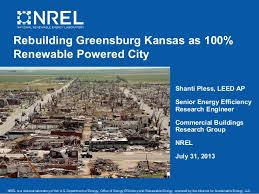
City Hall Destroyed in the tornado, City Hall has been rebuilt green incorporating solar panels, ground source heat pumps, reclaimed materials, and a vegetated roof. The building serves as a symbol of Greensburg’s vitality and leadership in becoming a sustainable community where social, environmental, and economic concerns are held in balance. The new Greensburg City Hall is projected to achieve more than 38% energy savings compared to a similar building built to standard code due in part to the 4.8-kilowatt (kW) rooftop photovoltaic (PV) system and ground source heat pumps.
100% Renewable Energy, 100% of the Time The Greensburg Wind Farm consists of 10 1.25 megawatt (MW) wind turbines that supply 12.5 MW of renewable power to the town. That’s enough energy to power every house, business, and municipal building in Greensburg. The town will use only about 1/4 to 1/3 of the power generated to
reach its “100% renewable energy, 100% of the time” goal. Excess power will be placed back on the grid and offered as renewable energy credits for other Kansas Power Pool and NativeEnergy customers. The wind farm was completed in the spring of 2010. John Deere Renewable Energy built the wind farm and maintains the project.
LEED® Platinum A key area of interest is the decision of the town to rebuild with the goal of becoming LEED certified in all public buildings. LEED (Leadership in Energy and Efficiency design) certification is available at several levels and correlates with the “green” level of the building. Greensburg worked to rebuild the school, city buildings, and other city buildings to meet LEED certification at the Platinum level. Completed in October 2009, Greensburg City Hall achieved the U.S. Green Building Council’s Leadership in Energy and Environmental Design (LEED®) Platinum designation. It is the first newly constructed LEED Platinum-certified city hall building in the United States. The 4,700-square-foot building houses the City’s administrative offices and council chambers, and serves as a gathering place for town meetings and municipal court sessions. NREL, with the support of DOE, provided technical assistance to determine the most cost-effective energy strategies for the building.
Energy Conservation The City Hall building incorporates the following energy efficient and renewable energy technologies.
Lighting
• Daylighting and lighting controls help limit the amount of artificial light needed
• Energy-efficient exterior lights save energy at night
• High performance windows allow natural light to offset electrical lighting and reduce heat loss in winter and heat gain in summer
• A solar-powered outdoor sign, designed to resemble the exterior of City Hall, gathers and stores electricity to illuminate the sign at night using energy-efficient light emitting diodes (LEDs)
Building Envelope and Insulation
• R-22 insulated concrete forms insulate the building
• A thin film PV panel is integrated into the standing seam metal roof with polyisocyanurate insulation providing an insulation value of R-30
• South-facing roof surfaces are sloped at an angle to harness solar energy
Heating, Ventilation, and Air Conditioning (HVAC)
• High-efficiency ground source heat pumps with variable speed motors and two stage compressors help meet part load conditions
• The all-electric heating and hot water system takes advantage of the abundant renewable electricity from the Greensburg Wind Farm
• Humidity sensors allow heat pumps to slow fan speeds and provide dehumidification
• A permanent carbon dioxide system provides feedback on whole-building ventilation system performance and can reduce outdoor air loads when the building is minimally occupied Renewable Power
• A 4.8-kW PV system installed on the roof provides more than 11% of the building’s energy and generates 7,234 kWh annually
• An open-loop ground source heat pump system provides heating and cooling
Sustainable Features
Greensburg City Hall incorporates a number of sustainable features to reduce the ecological impact of the building and to help its employees and visitors enjoy a healthy, safe environment.
Sustainable Site
The east end of the roof features a 2,800-square-foot vegetated area to help reduce the urban heat island effect and protect the building from weather. Varieties of native plant life are incorporated into the rooftop garden to retain heat that would otherwise seep into the building and increase energy bills and strain on the HVAC system.
Water Efficiency
Dual-flush toilets and waterless urinals reduce wastewater generation by more than 50%. Additional water-saving measures include low-flow faucets with automatic controls and rainwater collection and storage on the rooftop garden. The garden absorbs large amounts of water that is used to irrigate the native plant landscape.
Materials
City Hall is constructed with durable and meaningful materials, including regional Elmwood and reclaimed brick from the destroyed Greensburg Power Plant. Materials made of recycled content are used throughout the building, including Gypsum wall board, solid surface sills, countertops, and ceramic tiles. An effort was made to use both interior and exterior materials that were extracted and manufactured within the region.
Indoor Air Quality
To ensure a healthy and safe environment for employees and visitors, nontoxic, low volatile organic compound products were used, including paint, adhesives, sealants, interior composite wood, and agrifiber items. The City plans to survey building occupants within six to 18 months of occupancy; if more than 20% of staff are dissatisfied with air quality the city will develop a plan of corrective action.
Results
According to energy analysis modeling results, City Hall is 38% more energy efficient than an ASHRAE-compliant building of the same size and shape. Applying
the savings from the 4.8-kW PV system, City Hall achieves an additional 8% in annual electricity savings for a total energy use savings of approximately 46%. Energy modeling indicates that annual energy costs for a building similar to Greensburg City Hall built to standard code (the left column) would be approximately $15,800. The right column represents the expected annual energy costs for Greensburg City Hall. Thanks to the PV and ground source heat pump systems, high-performance building envelope, and the Greensburg Wind Farm, City Hall’s total annual energy costs are expected to be approximately $7,100—a reduction of more than 44%.

Αφήστε μια απάντηση